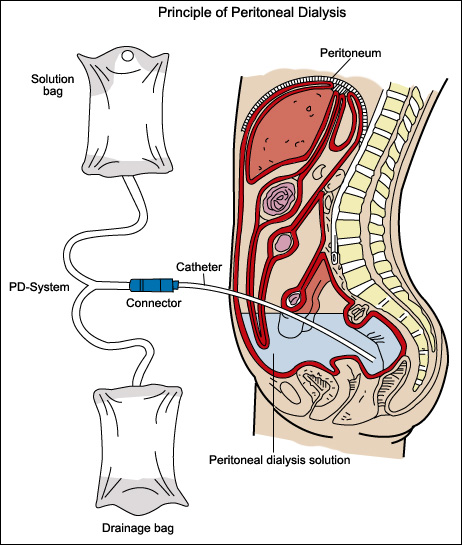Peritoneal Dialysis
Peritoneal dialysis (per-ih-tuh-NEE-ul di-AL-uh-sis) is a way to remove waste products from the blood when the kidneys can no longer do their job adequately. During peritoneal dialysis, blood vessels in the stomach’s abdominal lining, the peritoneum, filter much like the kidneys with the help of a dialysate fluid that goes in and out in cycles through a catheter in the abdomen.
How Does Peritoneal Dialysis Work?
PD uses the thin lining of the abdomen called the peritoneum as a filter. During treatments, a cleansing fluid called dialysate is cycled into the patient’s abdomen through a small, flexible tube called a PD catheter.
The dialyzate absorbs or pulls extra waste and fluids from blood vessels in the abdominal lining into the peritoneal cavity where it stays in the abdomen for a specified amount of time (dwell time).
The PD machine then drains the fluid out of the abdomen and into a drain or waste bag and the excess wastes and fluids are removed from the body.
Then, fresh dialysate is sent back into the to peritoneum to clean the blood once more. This filling and draining process is called an exchange or cycle.

Is There More Than One Form of PD?
There are two forms of peritoneal dialysis:
Continuous Ambulatory Peritoneal Dialysis (CAPD)
CAPD is peritoneal dialysis that can be done manually, without a machine, throughout the day. The patient fills his or her abdomen with dialysis solution and later drains the fluid. Gravity moves the fluid through the tube and into and out of the belly.
Each exchange includes filling the abdomen with dialysate fluid, letting the fluid dwell in the abdomen, and then draining the fluid. Patients may need three to four exchanges during the day and one with a longer dwell time while sleeping. Exchanges can be done at home, work or any clean place. During CAPD, patients are free to go about their normal activities while the dialysis solution dwells in their abdomen between exchanges.
Continuous Cycling Peritoneal Dialysis (CCPD)
With CCPD, which may also be called automated peritoneal dialysis (APD), a machine called an automated cycler performs three to five exchanges at night while the patient sleeps. The cycler automatically fills the abdomen with dialysis solution, allows it to dwell there and then drains it to a sterile drainage bag that is then discarded in the morning. This gives patients more flexibility during the day, but they must remain attached to the machine for 10 to 12 hours at night. In the morning, they begin one exchange with a dwell time that lasts the entire day.
The form of peritoneal dialysis that is best for each patient depends on their lifestyle, personal preferences and medical condition. Some patients may use a customized program that combines the two forms.
What are the Advantages and Disadvantages of Peritoneal Dialysis?
The benefits of PD include:
- Fewer negative side effects (such as nausea, vomiting, cramping, and weight gain) than with hemodialysis
- Provides continuous therapy, which acts more like natural kidneys
- Can allow for fewer dietary restrictions
- Needle-free treatments
- Direct shipment of PD supplies to your home or travel destination
- Do not have to travel to the dialysis center for treatments
- Greater flexibility and freedom in your treatment schedule
- Can do dialysis while sleeping
- Allows for travel
The disadvantages of PD include:
- Must schedule dialysis into your daily routine, seven days a week
- Requires a permanent catheter, outside the body
- Runs the risk of infection/peritonitis
- May gain weight/have a larger waistline
- Very large people may need extra therapy
- Need ample storage space in your home for supplies
- Need space in your bedroom for equipment and PD machine
- Requires responsibility and detailed training
How do I Prepare for Peritoneal Dialysis?
Before you start peritoneal dialysis you will need an operation to insert the peritoneal catheter, a soft plastic tube that carries the dialysis solution in and out of your abdomen. In children, this is done under general anesthesia, and adults may either receive local anesthetics or general anesthetics for the surgical procedure. It is best to give your catheter a few weeks to heal before starting dialysis treatments.
You will receive intensive training on what the procedure involves and how to use the equipment safely. You will also meet with a dialysis nurse and nutritionist. It may be a good idea to also have a family member trained to help you. Be sure to find out your new dietary and fluid restrictions when meeting with the nutritionist. Visit our ‘Diet and Nutrition’ tab for more information on a renal diet.
Most centers will admit their patients to the hospital to start dialysis and get on a good schedule that maintains proper labs and fluid balance.
Who Qualifies for Peritoneal Dialysis?
Peritoneal dialysis isn’t an option for everyone with kidney failure. The abdomens of some patients, particularly those who are morbidly obese or those with multiple prior abdominal surgeries, may make peritoneal dialysis treatments difficult or even impossible.
The patient and/or caregiver must have the ability to use fine motor skills and good eyesight. Cleanliness is a huge factor, and PD requires a sterile environment. The home of the patient must remain very clean.
There also needs to be ample storage space for PD supplies and a space in the home for the PD machine and supplies. It is best to speak with your dialysis team to determine which type of dialysis is right for you or your loved one.



